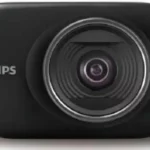

PHILIPS Electric Toothbrush DailyClean

PARTS

Introduction
Congratulations on your purchase and welcome to Philips! To fully benefit from the support that Philips offers, register your product at www.philips.com/welcome.
Important safety information
Read this important information carefully before you use the appliance and save it for future reference.
Note: The accessories and features of different models vary. For example, some models come with a sanitizer or are equipped with Bluetooth.
DANGER
- Keep the charger and/or sanitizer away from water. Do not place or store the appliance where it can fall or be pulled into a tub or sink.
- Do not immerse the charger and/or sanitizer in water or any other liquid.
- After cleaning, make sure the charger and/or sanitizer is completely dry before you connect it to the wall socket.
WARNINGS
- This appliance can be used by children and persons with reduced physical, sensory or mental capabilities or lack of experience and knowledge if they have been given supervision or instruction concerning use of the appliance in a safe way and understand the hazards involved. Cleaning and user maintenance shall not be made by children without supervision.
- Children shall not play with the appliance.
- If the appliance is damaged in any way (brush head, toothbrush handle, charger and/or sanitizer), stop using it.
- The mains cord cannot be replaced. If the mains cord is damaged, discard the charger and/or sanitizer.
- Always replace the charger and/or sanitizer with one of the original type in order to avoid a hazard.
- To recharge the battery with the travel case, only use the detachable USB cable and wall adapter if provided with this appliance.
- This appliance contains no user-serviceable parts. If the appliance is damaged, contact the Consumer Care Center in your country (see ‘Warranty and support’).
- Keep the cord away from heated surfaces.
- Do not use the charger and/or sanitizer outdoors or near heated surfaces.
CAUTION
- Do not clean the brush head, handle, charger, charger cover or sanitizer in the dishwasher.
- If you have had oral or gum surgery in the previous 2 months, consult your dentist before you use this appliance.
- Consult your dentist if excessive bleeding occurs after using this appliance or if bleeding continues to occur after 1 week of use. Also consult your dentist if you experience discomfort or pain when you use this appliance.
- This Philips appliance complies with the safety standards for electromagnetic devices. If you have a pacemaker or other implanted device, contact your doctor or the appliance manufacturer of the implanted appliance prior to use.
- If you have medical concerns, consult your doctor before you use this appliance.
- This appliance has only been designed for cleaning teeth, gums and tongue. Do not use it for any other purpose. Stop using the appliance and contact your doctor if you experience any discomfort or pain.
- This appliance is a personal care device and is not intended for use on multiple patients in a dental practice or institution.
- Do not use other brush heads than the ones recommended by Philips Sonicare.
- Stop using a brush head with crushed or bent bristles. Replace the brush head every 3 months or sooner if signs of wear appear.
- If your toothpaste contains peroxide, baking soda or bicarbonate (common in whitening toothpastes), thoroughly clean the brush head with soap and water after each use. This prevents possible cracking of the plastic.
- Avoid direct contact with products that contain essential oils or coconut oil. Contact may result in bristle tufts dislodging.
Electromagnetic fields (EMF)
This Philips appliance complies with all applicable standards and regulations regarding exposure to electromagnetic fields.
Your Philips Sonicare toothbrush
- Hygienic travel cap
- Brush head
- Handle
- Power on/off button
- Battery level indicator
- Charger
Note: The content of the box may vary based on the model purchased.
Getting started
Attaching the brush head
- Align the brush head so the bristles point in the same direction as the front of the handle.
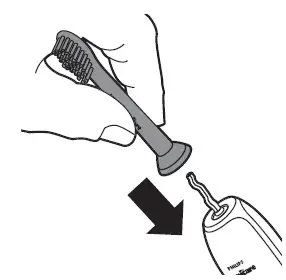
- Firmly press the brush head down onto the metal shaft until it stops.
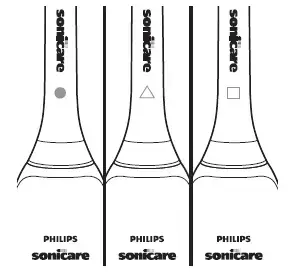
Note: Philips Sonicare brush heads are imprinted with icons to easily identify your brush head.
Charging your Philips Sonicare
- Plug the charger into a live electrical outlet.
- Place the handle on the charger.
The light of the battery level indicator flashes and the appliance beeps twice. This indicates that the toothbrush is charging.
Note: It can take up to 24 hours to fully charge the battery, but you can use the Philips Sonicare toothbrush before it is fully charged.
Using your Philips Sonicare toothbrush
Brushing instructions
- Wet the bristles and apply a small amount of toothpaste.
- Place the toothbrush bristles against the teeth at a slight angle (45 degrees), pressing firmly to make the bristles reach the gumline or slightly beneath the gumline.
Note: Keep the center of the brush in contact with the teeth at all times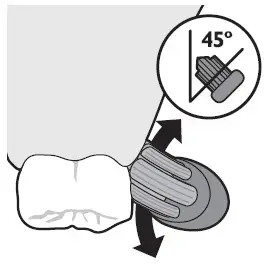
- Press the power on/off button to turn on the Philips Sonicare.
- Gently keep the bristles placed on the teeth and in the gumline. Brush your teeth with small back and forth motion so the bristles reach between the teeth. Continue this motion throughout your brushing cycle.
Note: The bristles should slightly flare. Do not scrub. - To clean the inside surfaces of the front teeth, tilt the brush handle semi-upright and make several vertical overlapping brushing strokes on each tooth.
Note: To make sure you brush evenly throughout the mouth, divide your mouth into 4 sections using the Quadpacer feature (see chapter ‘Features’).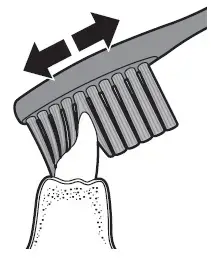
- Begin brushing in section 1 (outside upper teeth) and brush for 30 seconds before you move to section 2 (inside upper teeth). Continue brushing in section 3 (outside lower teeth) and brush for 30 seconds before you move to section 4 (inside lower teeth).
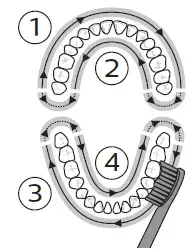
- After you have completed the brushing cycle, you can spend additional time brushing the chewing surfaces of your teeth and areas where staining occurs. You can also brush your tongue, with the toothbrush turned on or off, as you prefer.
Your Philips Sonicare toothbrush is safe to use on:- Braces (brush heads wear out sooner when used on braces)
- Dental restorations (fillings, crowns, veneers)
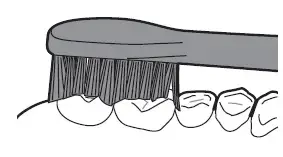
Note: Ensure that braces or dental restorations are properly adhered and not compromised. If not, braces or dental restorations may be damaged when they come into contact with the brush head.
Note: When the Philips Sonicare toothbrush is used in clinical studies, the handle should be fully charged and the Easy-start feature deactivated.
Battery status (when handle is not on charger)
This Philips Sonicare toothbrush is designed to provide at least 28 brushing sessions, each session lasting 2 minutes. The battery level indicator shows the battery status when you complete the 2-minute brushing session, or when you pause the Philips Sonicare toothbrush for 30 seconds while brushing by pressing the power on/off button.
Features
Intensities (specific types only)
Your power toothbrush gives you the option to choose between low and high intensity.
Note: When you use the toothbrush for the first time, the default setting is the low intensity.
- Press the power button once to turn on the toothbrush.
- Press a second time within 2 seconds to change the intensity.
- Press a third time within 2 seconds to pause.
After 2 seconds of brushing, pressing the power button again will also pause the toothbrush.
Smartimer
The Smartimer indicates that your brushing cycle is complete by automatically turning off the toothbrush at the end of the brushing cycle.
Dental professionals recommend brushing no less than 2 minutes twice a day.
Note: If you press the power on/off button after you started the brushing cycle, the toothbrush will pause. After a pause of 30 seconds, the Smartimer resets.
Easy-start
The Easy-start feature gently increases power over the first 14 brushings to help you get used to brushing with the Philips Sonicare toothbrush. This Philips Sonicare toothbrush comes with the Easystart feature activated.
Activating or deactivating Easy-start
- Put the handle on the plugged-in charger.
- Press and hold the power on/off button while the handle remains on the charger.
- Keep the power on/off button pressed until you hear a single short beep (after 2 seconds).
- Release the power on/off button.
Triple tone of low-med-high means the Easy-start feature has been activated.
Triple tone of high-med-low means the Easy-start feature has been deactivated.
Note:
- Each of the first 14 brushings must last at least 1 minute to move through the Easy-start ramp-up cycle properly.
- Use of the Easy-start feature beyond the initial ramp-up period is not recommended and reduces the effectiveness of the Philips Sonicare toothbrush in removing plaque.
- To achieve clinical efficacy, Easy-start needs to be deactivated.
Quadpacer
The Quadpacer is an interval timer that has a short beep and pause to remind you to brush the 4 sections of your mouth evenly and thoroughly. This Philips Sonicare toothbrush comes with the Quadpacer feature activated.
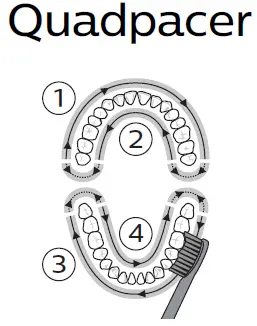
Charger confirmation
The handle beeps and vibrates briefly when it is placed on the charger base. This Philips Sonicare toothbrush comes with the charger confirmation feature activated.
Cleaning
You should clean your Philips Sonicare toothbrush regularly to remove toothpaste and other residue.
Failure to clean your Philips Sonicare toothbrush may result in an unhygienic product and damage to it may occur.
Warning: Do not clean brush heads, the handle or the charger in the dishwasher.
Warning: Do not clean with boiling hot water.
Toothbrush handle
- Remove the brush head and rinse the metal shaft area with warm water. Make sure you remove any residual toothpaste.
Caution: Do not push on the rubber seal on the metal shaft with sharp objects, as this may cause damage. - Wipe the entire surface of the handle with a damp cloth.
Note: Do not tap the handle on the sink to remove excess water.

Brush head
- Rinse the brush head and bristles after each use.
- Remove the brush head from the handle and rinse the brush head connection with warm water at least once a week. Rinse the travel cap as often as needed.
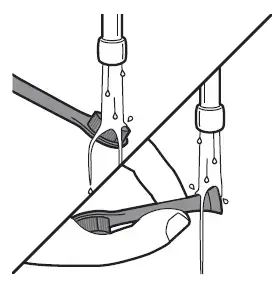
Charger
- Unplug the charger before you clean it.
- Wipe the surface of the charger with a damp cloth.
Storage
If you are not going to use the product for a long time, unplug it, clean it (see chapter ‘Cleaning’) and store it in a cool and dry place away from direct sunlight.
Replacement
Brush head
Replace Philips Sonicare brush heads every 3 months to achieve optimal results. Use only Philips Sonicare replacement brush heads.
Recycling
- This symbol means that this product shall not be disposed of with normal household waste (2012/19/EU).
- This symbol means that this product contains a built-in rechargeable battery which shall not be disposed of with normal household waste (2006/66/EC). Please take your product to an official collection point or a Philips service center to have a professional remove the rechargeable battery.
- Follow your country’s rules for the separate collection of electrical and electronic products and rechargeable batteries. Correct disposal helps prevent negative consequences for the environment and human health.
Removing the rechargeable battery
Warning: Only remove the rechargeable battery when you discard the appliance.
Make sure the battery is completely empty when you remove it.
Warning: Please note that this process is not reversible.
To remove the rechargeable battery, you need a towel or cloth, a hammer and a flat-head (standard) screwdriver. Observe basic safety precautions when you follow the procedure outlined below. Be sure to protect your eyes, hands, fingers, and the surface on which you work.
- To deplete the rechargeable battery of any charge, remove the handle from the charger, turn on the Philips Sonicare toothbrush and let it run until it stops. Repeat this step until you can no longer turn on the Philips Sonicare toothbrush.
- Remove and discard the brush head. Cover the entire handle with a towel or cloth.
- Hold the top of the handle with one hand and strike the handle housing 0.5 inch above the bottom end. Strike firmly with a hammer on all 4 sides to eject the end cap.
Note: You may have to hit on the end several times to break the internal snap connections. - Remove the end cap from the toothbrush handle. If the end cap does not release easily from the housing, repeat step 3 until the end cap is released.
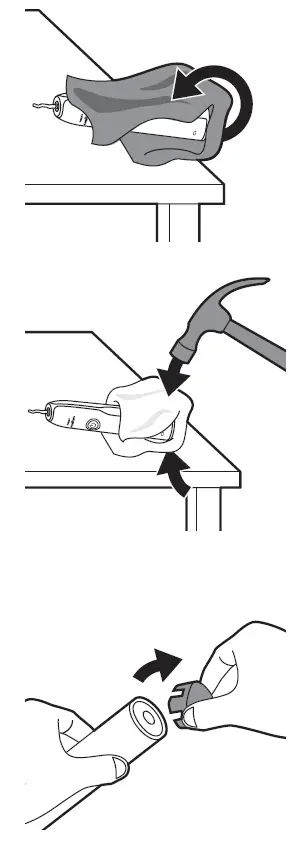
- Holding the handle upside down, press the shaft down on a hard surface. If the internal components do not easily release from the housing, repeat step 3 until the internal components are released.
- Remove the inner assembly from the housing by fully inserting a small flat-head screwdriver into the slot opposite the circuit board and pry until it comes apart.
- Grab the battery and pull it out of the internal assembly.
Caution: Be aware of the sharp edges of the battery tabs so as to avoid injury to your fingers. - Cut the battery wires from the circuit board close to the battery.
Caution: Do not cut the two wires at the same time.
- Cover the battery contacts with tape to prevent any electrical short from residual battery charge. The rechargeable battery can now be recycled and the rest of the product discarded appropriately.
Warranty and support
If you need information or support, please visit www.philips.com/support or read the international warranty leaflet.
Warranty restrictions
The terms of the international warranty do not cover the following:
- Brush heads.
- Damage caused by use of unauthorized replacement parts.
- Damage caused by misuse, abuse, neglect, alterations or unauthorized repair.
- Normal wear and tear, including chips, scratches, abrasions, discoloration or fading.


